Erin Driessen – 10 January, 2012
Yet, Hotere is nowhere. His works are never about him. They may express an opinion, a reaction to cultural happenings or a personal literary interest, but they are never about him. Over four decades, Hotere's work has developed with a sophistication and cultural awareness that is more about place than persona.
Dunedin
Ralph Hotere
Zero to Infinity
Curated by Natalie Poland
9 July 2011 - 18 February 2012
Ralph Hotere is represented by every major art gallery in the country. He is constantly deemed New Zealand’s most significant living artist. He has recently been made a Member of the Order of New Zealand. Ralph Hotere is everywhere.
Yet, he is nowhere. His works are never about him. They may express an opinion, a reaction to cultural happenings or a personal literary interest, but they are never about him. Over four decades, Hotere’s work has developed with a sophistication and cultural awareness that is more about place than persona. These works are consistent in style and treatment, but individually are unequivocally of their own time. Their contribution to the visual and social history of New Zealand is clear.
In honour of Hotere’s 80th birthday last year, many national galleries staged celebratory exhibitions of his work. The Hocken Gallery in Dunedin currently displays Zero to Infinity, curated by Natalie Poland. The exhibition was due to come down in October 2011, but has been extended to February this year. The title Zero to Infinity refers respectively to Hotere’s Zero series of 1966-7, and the recurring infinity symbol visible in his work.
I often find the Hocken Gallery space disruptive to large exhibitions, but Poland has used it particularly well here. The fifty works are not arranged chronologically but more thematically. One end room houses four large red and black works, each made from different materials like board, corrugated steel, plywood and cardboard. Zero Beginning (1966-7) is also hung in this room. Visually, it is a sore thumb, with its bright green square more an assault to than a break in all the black.
Upon leaving the red and black room, the viewer is confronted with White Drip To Mr Paul Holmes (2003). It is a large vertical strip of black corrugated iron, with a white line running down the middle ending at a red X. A witty and pointed retort to the broadcaster’s “cheeky darkie” comment, the work is a prime example of Hotere’s principled conviction in expressing his own (and others’) views on social events.
The lesser-known, or lesser-seen, works are a treat. Especially fine among these are Hotere’s designs and illustrations for programmes of poetry readings and performances. Created in watercolour and ink, the female figure drawn for the ‘Anatomy of a dance’ poster (1975) is Picasso-esque in its simplicity. Seemingly quickly sketched, the figure is drawn with just enough weight and space so that on its own, line becomes form.
The room at the other end of the space houses these kinds of smaller and more delicate works. Among these hang the two large works Black Painting (1969) and Black Painting XII from “Malady” (1970). They do not detract from the delicacy of the paper works, but rather add to the literary presence with their poetic subject matter. Black Painting repeats the word “SUNRISE,” a reference to “Dawn/Water”, a poem by Bill Manhire, while Black Painting XII repeats “MALADY” in a cross shape against a darker background.
A beautiful etching also hangs in this room, and the path I’d taken through the exhibition meant this was the last work I encountered. Below a heavy black square, an excerpt from Bill Manhire’s poem “The Wind” is scrawled in Hotere’s handwriting, one line of which reads:
What is this distance?
This question resonated as I read the words twice more before leaving the gallery. It stayed with me during my drive home. Now it still seems a pertinent one to try to answer, if only with more questions.
During my undergraduate years I purposefully avoided, or tried to avoid, writing about Ralph Hotere (as well as Colin McCahon and Frances Hodgkins). I felt there was nothing I could add, that I would only perpetuate misunderstandings or myths surrounding these big names (also, I probably didn’t have the guts to confront their work from my own point of view). Needless to say upon confronting Hotere’s work in this exhibition, I was relieved that I liked it. I couldn’t imagine rocking up to my computer to say, and say well, how and why I did not like the work of New Zealand’s most significant living artist.
But why not? It’s because Ralph Hotere is everywhere. We are constantly told and shown how great he is. I personally don’t dispute this opinion - I think the expressive sophistication and style of his art, his work on Observation Point and collaborations with New Zealand poets, among other achievements, all earn him the honour of Order of New Zealand Member - but it’s worth asking I think, what is the distance between Hotere’s work and the New Zealand art viewer? Is his work immediately accessible and understandable? Does it speak for the majority of New Zealanders? Do we automatically like him because we are told to, because he is everywhere?
Two photographs of Hotere, taken by Marti Friedlander in 1979 and 2000 respectively, hang beside the entrance to the gallery. The former shows Hotere outside, on the property of his Flagstaff Studio in Port Chalmers; in the latter, the artist peers into the camera from inside FHE Galleries in Auckland. Over time and throughout the country, Ralph Hotere has clearly become a revered figure not only in the art world, but in New Zealand social history. His status as such should not deter audiences, but actively encourage them to view his work from their own perspective and ask why is this so?
Erin Driessen
Recent Comments
John Hurrell
By 'cultural maturity' I'm talking about having open conversations about sacred cows now that were fairly unthinkable a couple of ...
Owen Pratt
Cultural Maturity? Cesarian birth straight into adolescent binge drinking;then middle aged bloat.
John Hurrell
One curator I know (I won't say who, so we don't have a public dismemberment) recently referred to Hotere's work ...
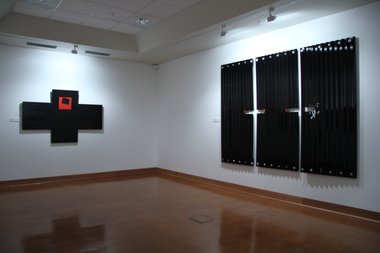
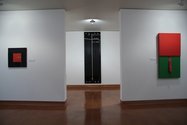

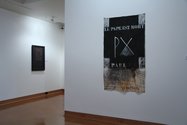

![Ralph Hotere, untitled [No. 8], c.1992, ink on paper: 760 x 570mm, Private Collection.](/media/thumbs/uploads/2012_01/Untited_No8_jpg_380x125_q85.jpg)
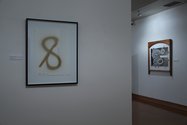
 Advertising in this column
Advertising in this column Two Rooms presents a program of residencies and projects
Two Rooms presents a program of residencies and projects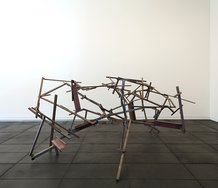
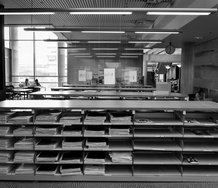
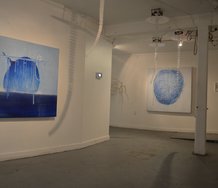
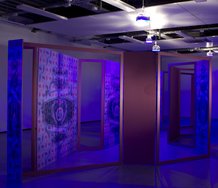
This Discussion has 18 comments.
Comment
John Hurrell, 1:05 a.m. 10 January, 2012 #
Hi Erin, can you tell us a bit more about why you argue Hotere's works are not about him? Where is the evidence for that - in the face of works like the Sangro series - on the death of his brother in Italy, which is clearly about grief. That personal emotive aspect is how he is understood by people like Jock Phillips. He stands for intense feeling. <http://realnzfestival.wordpress.com/2011/09/10/southern-man/>
Not everybody thinks he is New Zealand's greatest living artist. <http://eyecontactartforum.blogspot.com/2009/09/early-hotere-works-on-paper.html> Other contenders for that title might be Milan Mrkusich or Billy Apple.
Owen Pratt, 4 p.m. 13 January, 2012 #
Why make it an issue of personality John? (or brand when it comes to Mr Bates). I try to seperate art from artist and pin point great works from different periods.
If the title of greatest living artist is for the greatest number of great works from the most decades from these three contenders it is easily Ralph's victory. If it is up to and including current work he would be pipped by Apple.
However I think there are other younger contenders who are changing the way we look at the world almost every week, so this particular piece of the Emperor's clothing can be freely passed around.
John Hurrell, 4:16 p.m. 13 January, 2012 #
Well Erin brought the subject up in her second sentence and I'm pleased she did. Of course on one level it is trivialising RH's practice, esp if you (as you do) separate work from its creator. However your claim that the 'greatest number of great works from the most decades' come from Hotere is disputable, and as this site is a forum, it is reasonable to present other possibilities.
Erin Driessen, 9:29 a.m. 10 January, 2012 #
Hi John,
I think you have answered your own question with your comment, "He stands for intense feeling." Though they stem from his own experience, his feelings are expressed in an open and readable way. His works are honest and therefore I would argue most people could attach their own experiences or feelings to them, and without much conscious effort; the black paintings and Sangro works are powerfully evocative. Jock Phillips uses the word "mateship" with reference to Hotere's collaborations with others, and it's also a word applicable to the artist-audience relationship he establishes. He stands for something universal; his works don't stand in place of him.
Also, there is not an emphasis on physical process (different from artistic or conceptual process). For example, I find James Robinson's work appealing but I can never get past the artist in trying to understand the art.
It's so interesting how statements like "New Zealand's most significant living artist" can be made without "Many believe he is" as a prefix. This show plays it up a bit with a generalised blurb on one side of the entrance and two enigmatic photographs of the artist on the other. It's like, "we don't need to justify this, just read this wee thing and look at this guy." With so many galleries staging these celebratory shows, a catalogue essay arguing issues surrounding a statement like that would have been an appreciated and admirable addition to the Dunedin show.
John Hurrell, 10:47 a.m. 10 January, 2012 #
Ah yes but you think there is an inbuilt 'distance', no? That implies the works are not about the artist. I'm puzzled why you think that, and why the question of him speaking 'for the majority of New Zealanders' is relevent? Art doesn't have the enthusiastic support of say sport, so who cares what the majority think? Such empathy wouldn't make an artist great - rather it's the opposite, that to go against majority opinion is a sign of courage.
Erin Driessen, 1:18 p.m. 10 January, 2012 #
I think the concept of distance I have is the space between artist and viewer that is filled by myths or hyperbole. We shouldn't accept it as a given that he is a great artist; we have to confront his work ourselves and make up our own minds, and I think statements like "most significant artist" and a preoccupation with "artist genius" aspects like Hotere's reclusiveness, build him up as a mythic or unapproachable figure and may discourage audiences from examining his work more critically. When I did confront them myself, I found the distance between art and viewer very surmountable, as I tried to forget what I'd read or been told and just stay with the work myself. It's the idea that the distance is not as great as I preconceived it to be; his work isn't about this mythic figure, it's about humanity.
And I guess my "majority of New Zealanders" question relates to the ONZ membership, not to him being a great artist. But yes, I agree with you I don't think it's that relevant. The list of members surely supports that the majority vote is not required.
Erin Driessen, 1:22 p.m. 10 January, 2012 #
It's the culturally constructed distance between larger-than-life figure and viewer that DOES make the works about him; it shouldn't be that way. The ACTUAL distance between artwork and viewer is easily negotiated, which says to me his work is more about human nature than about him.
Andrew Paul Wood, 6:14 p.m. 10 January, 2012 #
I think this is a non-issue as it is entirely irrelevant to me whether the work is about Hotere or humanity - the work is simply the work and let's drop the unreliable narrator/autobiographical fallacy hooha and just enjoy the works for what they are - aesthetic objects in the international formal modernist mode with some specific local/personal/intertextual allusive signifiers. Sociologists like Roland Robertson call it “glocalisation” – thinking globally and acting locally.
Alice Jenkins, 11:04 p.m. 10 January, 2012 #
Agreed. And a distraction from the fact that for the large part Hotere is a poor man's McCahon.
Cynthia Bongolaire, 9:30 a.m. 11 January, 2012 #
I have to say I find it strange that the title of the show and it's relation to the works hasn't really been discussed. I can clearly see the symbol for infinity in a number of the paintings. If these are "infinity", is Paul Holmes the "zero"?
Erin Driessen, 10:11 a.m. 11 January, 2012 #
Hi Cynthia,
Yeah, I didn't really address it as to me it seemed just a conveniently vague concept. With many other galleries staging shows celebrating Hotere's 80th birthday, Poland had to work with the works to which she had access. 'Zero to Infinity' refers to the 'Zero' series and the infinity symbol, but as a concept it encompasses everything in between as well. Also, the infinity symbol next to a '0' makes '80' - Hotere's age. So I don't think there's that much to it; but then again, its vagueness leaves it open to interpretations like yours which I guess is constructive in a way.
Erin Driessen, 10:16 a.m. 11 January, 2012 #
Maybe 'vague' isn't the right word ... clearly it is a concept specific to Hotere's work. Insert 'obvious' instead.
Owen Pratt, 3:49 p.m. 13 January, 2012 #
..that would be infinity to zero then. = 80.
Erin Driessen, 4:53 p.m. 13 January, 2012 #
Indeed, Owen. The poster suggests both:
http://realnzfestival.files.wordpress.com/2011/09/img_1489-comp.jpg
Martin Langdon, 7:45 p.m. 25 January, 2012 #
maybe 'beyond' is alluded too in the title and how his relevance has been sustained and will continue to do so, with no real signs of slowing.
John Hurrell, 8:47 p.m. 25 January, 2012 #
One curator I know (I won't say who, so we don't have a public dismemberment) recently referred to Hotere's work as 'McCahon lite'. It is interesting that such a view is able to be expressed now, a sign of maturity in our culture that certain marketing myths about Hotere can be examined and pooh-poohed.
Owen Pratt, 10:55 p.m. 26 January, 2012 #
Cultural Maturity? Cesarian birth straight into adolescent binge drinking;then middle aged bloat.
John Hurrell, 11:34 p.m. 26 January, 2012 #
By 'cultural maturity' I'm talking about having open conversations about sacred cows now that were fairly unthinkable a couple of decades ago. Owen, I confess I'm not sure what you're getting at - in terms of artworld environment. The climate for dialogue.
Participate
Register to Participate.
Sign in
Sign in to an existing account.